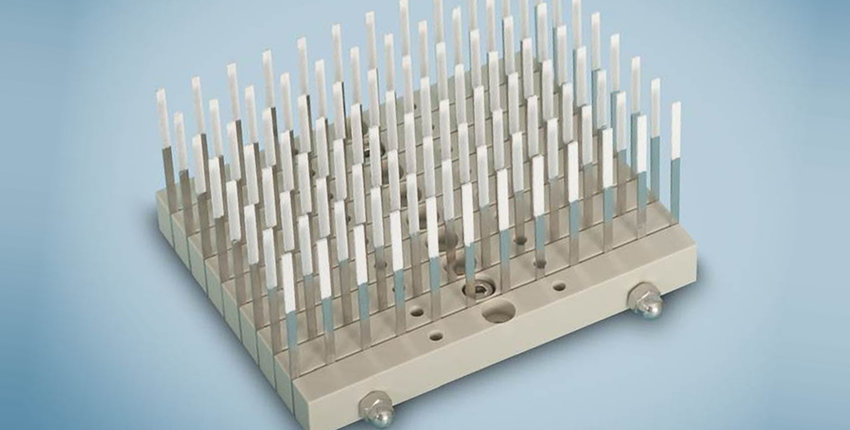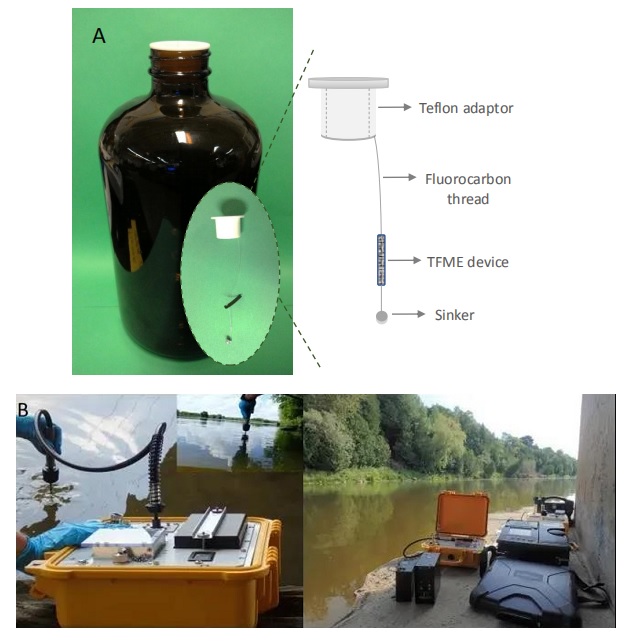Solid Phase Micro Extraction (SPME) is a widely used technique for extraction and concentration. Thin Film Microextraction, in short, TFME or Thin Film SPME / TF-SPME, is one type of SPME. It solves the problems of absorption rate and limit of absorption of fibre-SPME.
Features of
TF-SPME:
•
Suitable
for extraction of polar compounds from water-based
samples
•
Greatly improve the sensitivity by increasing the volume and surface-volume
ratio, without sacrificing the time of analysis
•
Require
less sample volume
•
TF-SPME
has two structure: brush-type structure suitable for high throughput
water samples in HPLC application; net-type structure suitable for
samples in GC application
1)
Brush-type
structure suitable for high throughput water samples in HPLC application
ü Coating: common sorbent materials found in SPE, can
direct contact with samples
ü Flat blade shape, have higher surface-volume ratio, work with 96-pos deep
well plates, can achieve analysis with high efficiency
ü Very complicated samples, like
analytes in homogeneous animal or plant tissue, will also be absorbed into the
sorbent materials
ü Impurities can be removed from TF by
cleaning with water
ü Sample preparation, extraction, cleaning and desorption can be automated by workstation

2)
Net-type
structure suitable for samples in GC application
ü TF is a sampling device to improve
the efficiency and sensitivity
of extraction. Mainly used with TDS of GC system
ü Use for active/onsite sampling. TF
contact with gas or liquid in a certain time
ü TF can be used to monitor the
release of VOCs from sample surface, such as human skin. It is a non-invasive method to monitor physiological responses
to diseases or stresses, or to monitor exposure of environmental chemicals.
ü In passive (integrated or time
weighted average, TWA) analysis, longer exposure times and larger films are
used. It can be used for monitoring the contaminants in water. Experiments
showed that the maximum time for linear adsorption can be from several hours to
several days
ü Extraction method: Direct immersion or headspace (higher sensitivity in general), extract VOCs from solid, liquid and gas samples, better for analysis of trace organic compounds
ü Similar technique to general SPME,
but compared to fibre-SPME, the flat shape and high surface-volume ratio of carbon mesh can provide larger volume for extraction and higher efficiency of
absorption.

Benefits of TF-SPME
- Efficient parallel sample extraction and optimized analysis system utilization
- Improved work environment due to solvent free extraction
- Efficient extraction, lower LODs, higher analyte recovery compared with SPME
Application of TF-SPME– Suitable for all applications of SPME
Thin-film Solid Phase Microextraction is an innovative, high sensitivity, solvent-free sample preparation technique, mainly used for extraction of VOCs and SVOCs in samples, followed by thermal desorption:
- Food Aroma/Flavour/Odour Analysis (Flavour of tea/fruit)
- Analysis and researches of VOCs in chemical industries (fragrances, consumables, materials, etc)
- Plant (Researches on plant aroma components, plant protection, TCM flavour, volatile oils)
- Analysis and research of volatile organic compounds in tobacco (tobacco, packing materials, flavour)
- Research of flavour of alcohol
- Environmental VOCs (Research topics – VOCs in air and water, pesticides in water)

Please contact us for more details

Leave a Comment